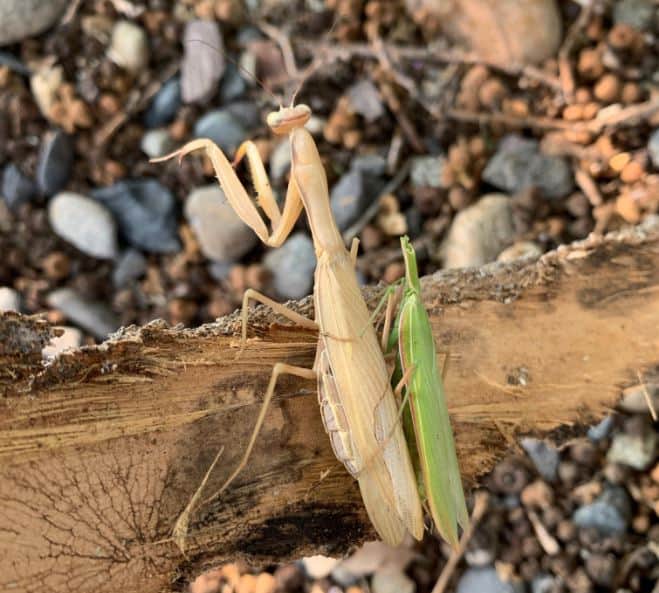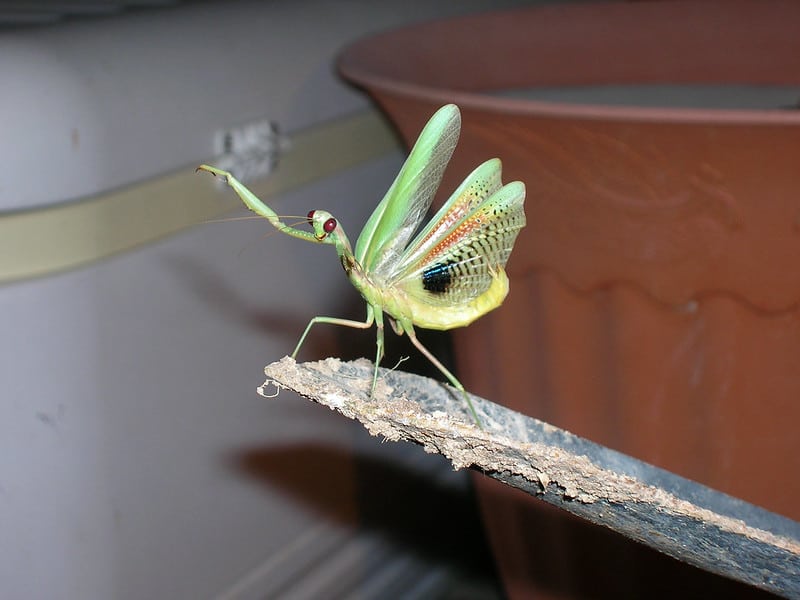Mantids are some of the most beautiful and exotic insects in the world. Their unique shape allows them to be some of the most fierce fighters in the animal world. With an amazing sight, fast reflexes, and razor-like front legs, they’re often able to catch prey and defeat predators several times their size.
Besides being ferocious insects, mantids often display bright colors and patterns that make them visually appealing. Combine this with the fact that they’re generally easy to take care of and harmless to human beings, and you’ll get why mantids are such popular pets.
If you’re into the exotic-pets hobby, chances are that you have a praying mantis, or you’re looking to add one to your collection.
Now, let’s say that you’re lucky enough to have a pet store nearby with mantids on display. You can head to the store, choose among the different mantis species available, and get the specimen (or several specimens) you wish for your collection.
As you look at the mantids for sale, you’ll most likely wonder which ones are the males and the females. Also, is sex relevant, or is there no difference between male and female mantids? This article will teach you the differences between the mantids two genders so you can tell them apart and choose what fits you best.
Physical Differences between Males & Females

The praying mantis, as a family of different species, exhibits something called sexual dimorphism. This means that male and female specimens of the same species don’t look the same, making the task of telling them apart much more manageable.
The gap between male and female specimens is wider in some species than others, but it’s never invisible. You’ll always be able to tell them apart if you know what to look for, which comes very handy if you’re picking them from a store and want to get enough of each for breeding.
Here are four aspects that will help you determine the sex of your praying mantis.
Color
A commonly asked question is whether a brown mantis is a male or a female, or whether their color says anything about their sex at all.
Generally speaking, sex does not affect the color of a mantis. Both males and females can be a variety of colors.
However, with over 1800 species, there is of course an exception. A newly discovered species called the Hondurantemna chespiritoi has different camouflage strategies for males and females. Males have a brown, stick-like appearance, whereas females are a leafy green color.
Size
Female mantids are larger and bulkier than male mantids. This difference may seem subtle at first sight, but it becomes much clearer once you place them next to each other and compare their sizes.
Thanks to this difference, female mantids are often better fighters, while male specimens have a larger tendency to try to escape.
Abdomen
The female mantid’s abdomen has six segments, and the male mantids have eight segments instead. This may seem odd, given that females are larger, but once you get used to watching them, you’ll notice that female segments are much longer than the male segments.
This is one of the easiest ways to tell them apart, as this rule always applies no matter the size or species.
Wings

This rule only applies to macropterous mantids, which are those praying mantids that have long wings; however, since almost every mantis species falls into this classification, it’s still a simple and reliable way to sex them.
You’ll notice that a female’s wings usually don’t reach the end of its abdomen. On the other side, a male mantis’ wings run longer than the abdomen, allowing it to fly better than females.
Antennae
The fourth aspect is similar to the first one, but it’s usually easier to tell without comparing them. The mantid’s antennae are longer and thicker in male specimens and slimmer in females. This most likely helps males during their flights since the antennae are part of a mantid’s sensory organs.
Lifespan
Insects usually don’t have a long life. Most hobbyists breed their own specimens to make sure to always have their favorite pets because of this.
If your pet’s lifespan is an important factor, you’d be inclined to choose a female specimen. They often have a longer lifespan than male mantids, so you’ll be able to enjoy them for longer.
Flight
Considering the physical differences between male and female mantids, it comes as no surprise that the male praying mantis is far better at flying. It gets to the point where some people don’t think female mantids fly as they don’t do it so often; however, they’re perfectly able to do it. They’re just less likely to.
Female mantids are slower and fly shorter distances than male mantids. If part of the appeal you’re looking for in your mantis is to see it flying around in your room, then you’ll likely want to get a male specimen. However, consider that you need to be careful with a flying mantis; you don’t want it to run into a ceiling fan or anything else that may harm it.
Power
Their bulkier and larger bodies make female mantids stronger and better suited for fighting. This doesn’t mean that males are completely helpless; they’re great hunters and have the same tools and fast reflexes as females.
However, regarding the size of the prey they can take down, a female mantis will always be more extraordinary. As a general rule, you don’t want to feed your mantis anything larger than one-third of its body.
However, if you’re interested in taking your chances and seeing your praying mantis take bigger prey, you should get a female specimen.
Behavior
It’s easy to see how the differences between male and female mantids affect their behavior. A female praying mantis is less likely to fly and shy away from trouble because it’s a slow flier, making its escapes less likely to succeed. Instead, it’ll often use its wings in a threat posture and take advantage of its bigger body to get the upper hand in a fight.
On the other hand, the male praying mantis has flying as its first defense mechanism when faced with danger. It’s a fast flier but not as powerful as a female, so it’s an easy choice for them. Other than this, male and female specimens have very similar behaviors.
Conclusion
Male and female mantids are very similar but have particular differences that make them special. Most people who know their differences conclude that having a female specimen over a male is better due to their larger lifespan and larger size.
However, the best approach is to get both and enjoy the differences that make them unique. This way, you’ll get the best of both worlds while also being able to breed them. In any case, we hope this article provided you with a clear view of the differences between male and female mantids and why it’s important you get both in your collection.
- How Long Do American Eskimo Dogs Live? Important Factors and Care Tips - September 29, 2023
- Do American Bulldogs Need Grooming? Essential Tips and Care Guidelines - September 29, 2023
- Do Bengal Cats Enjoy Playing? Essential Tips for Keeping Them Active - September 29, 2023